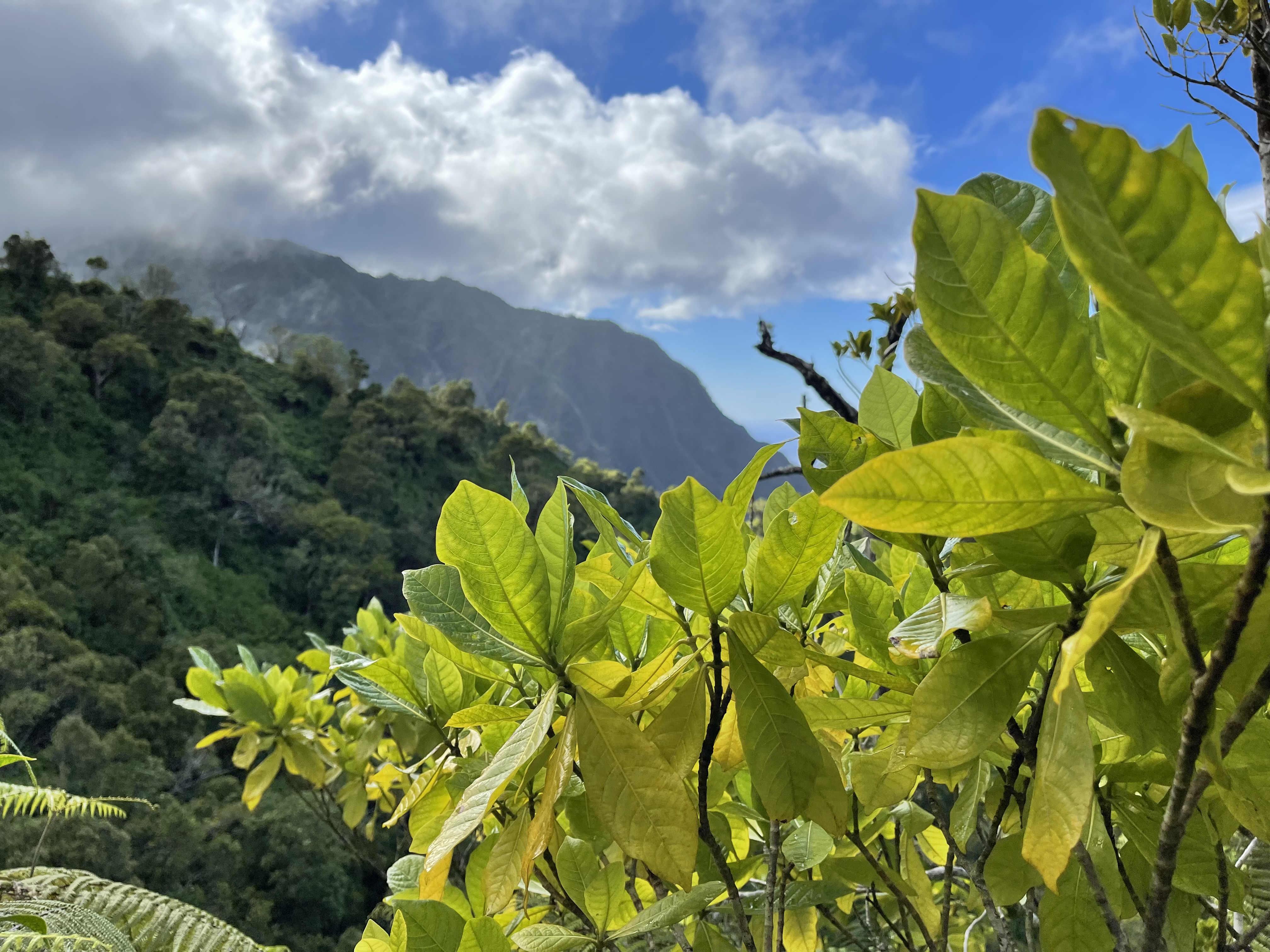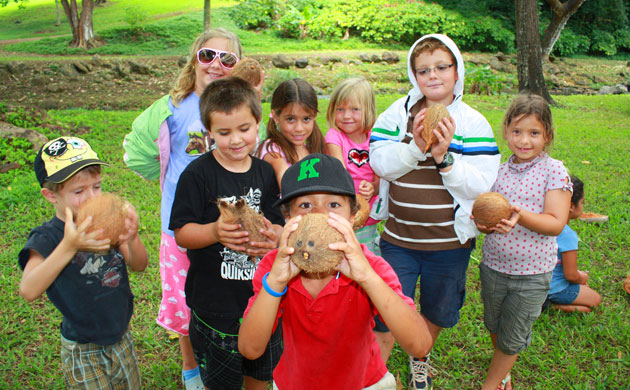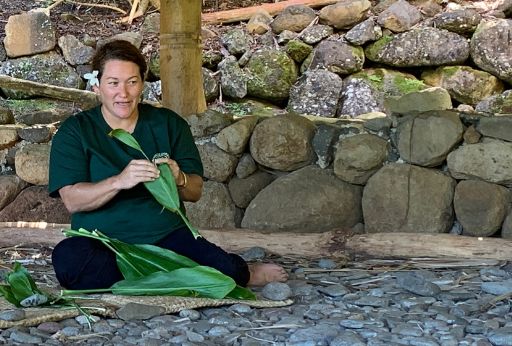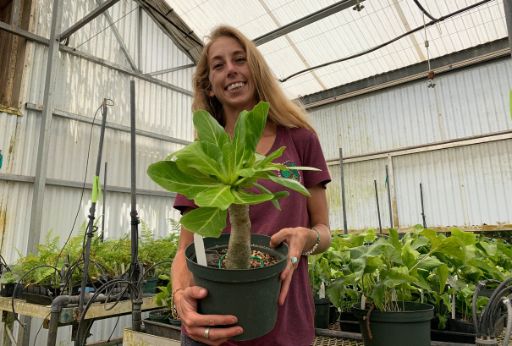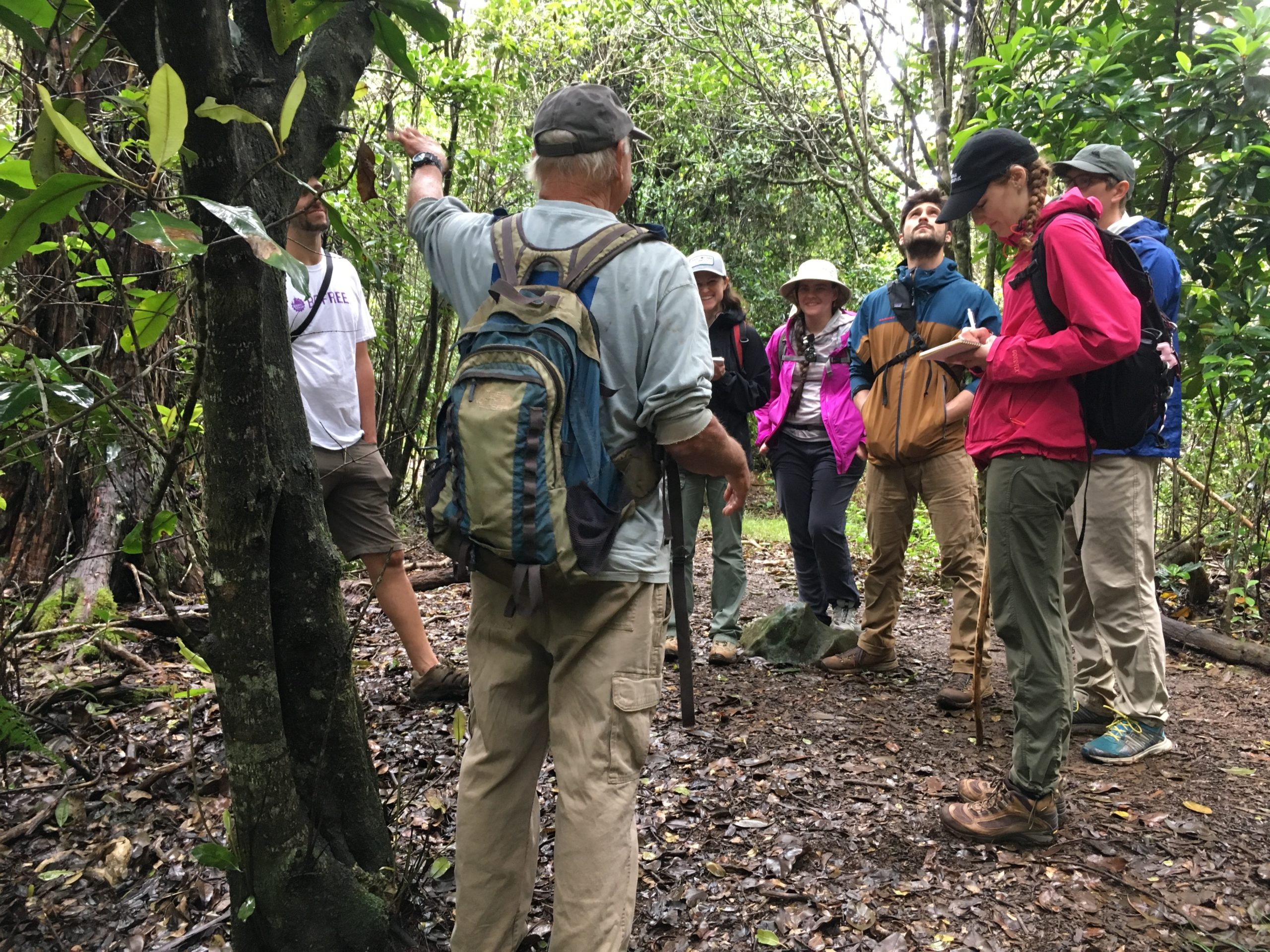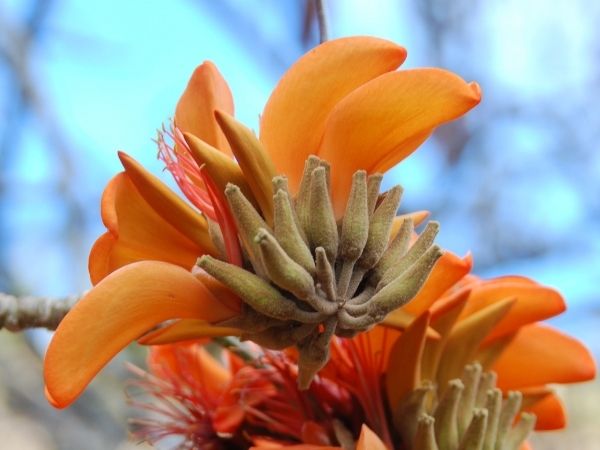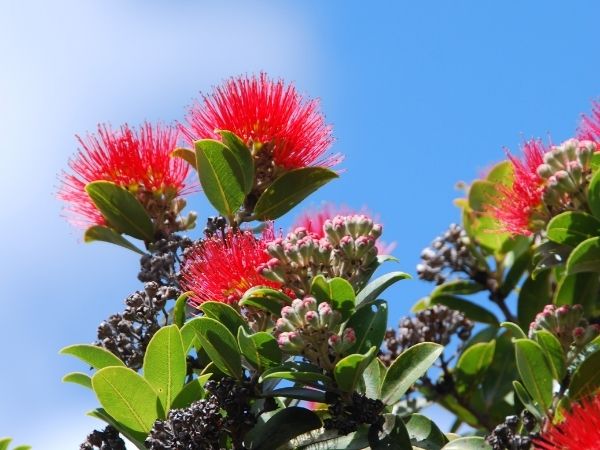Tropical Plant Database - Plant Details
Gardenia remyi
Conservation Status
- IUCN: critically endangered
- USFWS: Endangered
- Listed with CPC
- Listed with PEP
Genus: Gardenia
Species: remyi
Species Author: H. Mann
Vernacular: Nanu, Nau
A member of the Rubiaceae (Coffee) family, Gardenia remyi (known as Nanu in Hawaiian) is an endemic tree 3 to 13 m (10 to 43 ft) tall with branches that are quadrangular, covered in soft, downy hairs, and viscid. The leaves of Nanu are few, clustered towards the tips of the branches, and are elliptic to broadly elliptic or obovate. Flowers are fragrant (described as having delicate notes of cinnamon, vanilla, and coconut), solitary, and terminal, with a narrowly funnelform hypanthium (the bowl-shaped part of a flower on which the sepals, petals, and stamens are borne) and a six- to eight-lobed white corolla. Based on herbarium specimens and field observations, Gardenia remyi appears to flower year-round throughout its range. Fruits are orange, subglobose to broadly ellipsoid, while seeds are irregularly obovate.
- Wagner, W.L., Herbst, D.R., and Sohmer, S.H. 1999. Manual of the Flowering Plants of Hawaii. University of Hawaii Press and Bishop Museum Press, Honolulu.
- Wagner, W.L., Herbst, D.R., & Lorence, D.H. (2005-). Flora of the Hawaiian Islands website. http://botany.si.edu/pacificislandbiodiversity/hawaiianflora/index.htm
This database entry has been complied by Matthew Kahokuloa, Jr.
Gardenia remyi individuals have been outplanted within ungulate-proof exclosures. Feral pigs have been fenced out of the west Maui populations of Gardenia remyi, and non-native plants have been reduced in those areas. However, these threats are ongoing in the remaining, unfenced populations, and are therefore imminent. In addition, the threat from goats and deer is ongoing and imminent throughout the range of the species. All of the threats are of a high magnitude, because habitat destruction, predation, and landslides could significantly affect the entire species, resulting in direct mortality or reduced reproductive capacity, leading to a relatively high likelihood of extinction.
During the process of kapa (barkcloth) beating, the wood of Nanu was one used for kapa anvils, known as kua kuku. Also, the fruit pulp was used to make a yellow dye, described as a "bright golden yellow which does not fade when dried."
- Abbott, Isabella A. 1992. La'au Hawai'i: Traditional Hawaiian Uses of Plants. United States, Bishop Museum Press.
- Lamb, Samuel H. 1981. Native Trees & Shrubs of the Hawaiian Islands. United States, Sunstone Press.
Gardenia remyi (Nanu) is an endemic tree found on the Hawaiian Islands of Kauai, Molokai, Maui, and Hawaii, occuring in habitat ranging from mesic to wet forest and ridge shrubland, and wet cliff.
On the island of Hawai‘i, Gardenia remyi occurs in wet forest dominated by Acacia koa (koa)—Metrosideros polymorpha (‘Ohi‘a). On Maui, Gardenia remyi occurs in lowland wet forest dominated by Metrosideros polymorpha, Cheirodendron spp. ('Olapa), and Dicranopteris linearis (uluhe). On Molokai, Gardenia remyi occurs in Metrosideros polymorpha— Dicranopteris lowland wet forest. On Kauai, Gardenia remyi occurs on cliffs and ridges in Diospyros spp. (lama) mixed mesic forest, Metrosideros-Dicranopteris lowland wet forest, and on Dicranopteris-covered slopes.
Associated native species include Acacia koa, Alyxia stellata (maile), Antidesma platyphylla, Athyrium microphyllum, Bobea elatior ('ahakea), Boehmeria grandis ('akolea), Carex meyenii, Charpentiera spp. (papala), Cheirodendron spp., Chrysodracon aurea (hala pepe), Cibotium spp., Cyanea spp., Cyrtandra spp. (ha'iwale), Diplazium sandwichianum (ho'i'o), Dodonea viscosa ('a'ali'i), Doodia kunthiana ('okupukupu), Dubautia spp. (na'ena'e), Elaeocarpus bifidus (kalia), Freycinetia arborea, Hibiscus spp., Hydrangea arguta, Kadua affinis, Melicope spp., Myrsine lanaiensis, Nephrolepis exaltata, Perrottetia sandwicensis, Pisonia spp., Planchonella sandwicensis ('ala'a), Polyscias spp. ('ohe) Pritchardia spp. (loulu), Psychotria mariniana, Psydrax odorata (alahe'e), Rauvolfia sandwicensis (hao), Santalum spp. ('iliahi), and Syzygium sandwicensis ('ohi'a ha).
https://www.govinfo.gov/content/pkg/FR-2014-12-05/pdf/2014-28536.pdf#page=1
Pollination of Gardenia remyi is unknown but the flower is white and very fragrant, which may be indicative of insect or moth pollination. Gardenia remyi also has well developed fleshy fruit, a feature suggesting bird ingestion and defecation as the dispersal mechanism. It is possible that native frugivorous forest birds or possibly flightless waterfowl were seed dispersers. In cultivation, Gardenia remyi fruit have been observed to dehisce (gape or burst open), which could be another seed dispersal method.
- Sakai, A., W. Wagner, D. Ferguson, and D. Herbst. 1995. Origins of dioecy in the Hawaiian flora. Ecology 76(8): 2517–2529.
- Carlquist, S. 1980. Hawaii a natural history, geology, climate, native flora and fauna above the shoreline. 2nd edition, Pacific Tropical Botanical Garden, Honolulu. 468 pp.
In reference to native Hawaiian names, Hillebrand stated that "Nanu" was the name of both Gardenia remyi and Gardenia brighamii. Later it was stated by Brigham that, "The native name Nanu was applied to Gardenia remyi and na'u to Gardenia brighamii." Since this distinguishes the two, his interpretation will be followed, and "Nanu" adopted for Gardenia remyi. Brigham adds that the fruit pulp of both species was used for dyeing yellow the "kapa" or bark cloth of the natives.
- St. John, H. and J.R. Kuykendall. 1949. Revision of the Native Hawaiian Species of Gardenia (Rubiaceae). Hawaiian Plant Studies-15. Brittonia, vol. 6, no. 4, pp. 431–449. JSTOR, www.jstor.org/stable/2804926
IUCN Status: Critically Endangered (CR): Total number of mature individuals is less than 250 (82); it has an observed continuing decline, and less than 50 mature individuals occur in each subpopulation (16 mature individuals occur in the largest subpopulation).
Federal Listing Status: Endangered (E).
Gardenia remyi is threatened by pigs, rats, goats, deer, and nonnative invertebrates (e.g., slugs) which degrade and destroy habitat and possibly forage upon the species, and by nonnative plants that outcompete and displace it. Gardenia remyi is also threatened by landslides and reduced reproductive vigor. This species is represented in ex situ collections.
- Grave, E., Walsh, S., Keir, M., Wood, K. & Nyberg, B. 2020. Gardenia remyi. The IUCN Red List of Threatened Species 2020: e.T33566A83801135. https://dx.doi.org/10.2305/IUCN.UK.2020-3.RLTS.T33566A83801135.en
- https://ecos.fws.gov/ecp/species/5835
A PhD research project at the National Tropical Botanical Garden is investigating the role of Arbuscular Mycorrhizal Fungi and plant genetic variation in propagation and conservation planning of Gardenia remyi in Hawai'i. It has also been proposed that this species could have originated from Gardenia taitensis but more research is needed to understand the origin and relationships of this and other Hawaiian Gardenia species.
- 019066 - collected by Tim Flynn in 1987
- 018615 - collected by Steve Perlman in 1987
- 019065 - collected by Tim Flynn in 1987
- S064120 - collected by Tim Flynn in 1987
- 012758 - collected by Steve Perlman in 1989
- 006962 - collected by Steve Perlman in 1989
- 015264 - collected by K. R. Wood in 1991
- 012557 - collected by Steve Perlman in 1991
- 012563 - collected by Steve Perlman in 1991
- 014639 - collected by K. R. Wood in 1992
- 019443 - collected by Steve Perlman in 1994
- 019417 - collected by Tim Flynn in 1995
- 021369 - collected by K. R. Wood in 1997
- 055638 - collected by J. Scott Meidell & Hank Oppenheimer in 1997
- 044027 - collected by K. R. Wood in 1998
- 044028 - collected by K. R. Wood in 1998
- S064121 - collected by K. R. Wood in 1998
- 034197 - collected by Steve Perlman in 2001
- 055096 - collected by K. R. Wood in 2001
- 054820 - collected by K. R. Wood in 2001
- 087081 - collected by K. R. Wood in 2002
- 061884 - collected by K. R. Wood in 2004
- 061849 - collected by K. R. Wood in 2004
- 050437 - collected by Hank Oppenheimer in 2005
- 061146 - collected by Natalia Tangalin in 2011
- 069064 - collected by Hank Oppenheimer in 2014
- 085441 - collected by K. R. Wood in 2015
- 085440 - collected by K. R. Wood in 2015
- 076523 - collected by K. R. Wood in 2017
- 082933 - collected by K. R. Wood in 2018
- 080542 - collected by K. R. Wood in 2019
- 082436 - collected by K. R. Wood in 2020
- 086021 - collected by K. R. Wood in 2021
- 088119 - collected by David H. Lorence in 2021
- 087943 - collected by Hank Oppenheimer in 2021
We currently have 35 herbarium specimens for Gardenia remyi in our collection. Click on any specimen below to view the herbarium sheet data.
.svg)


